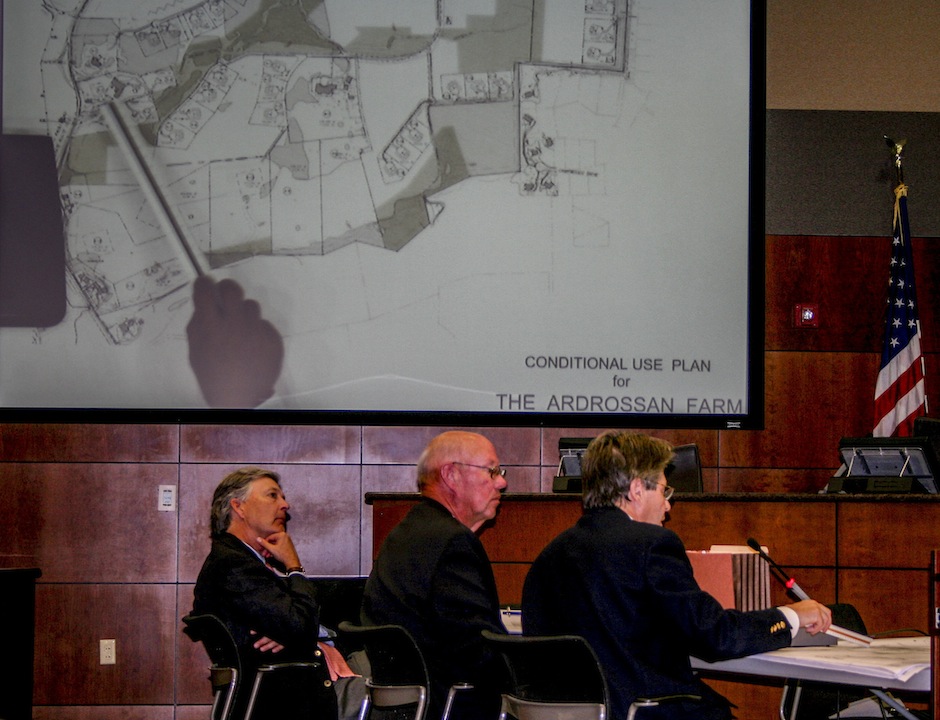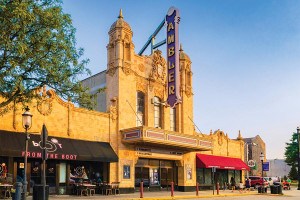Radnor Township Hearing About Ardrossan Gets — You Guessed It — Contentious
Monday night at a Radnor Township conditional use hearing, Hope Montgomery Scott heir Edgar Scott III told hearing officer Bill Bolla that he hoped to find “like minded people” to buy some large tracks of land, along with a proposed 64 to 87 smaller home lots that comprise the remaining 311 acres of the iconic Ardrossan Farm.
The purpose of the hearing was for Bolla, on behalf of Radnor Township, to determine if Scott’s plan meets the criteria of the township ordinance that allows developers to build homes on lots that are smaller than what are usually allowed, based on standard zoning rules.
Scott’s company, which applied for the conditional use is called E.S. LP. He was represented at the hearing by John Snyder a partner at the Saul Ewing law firm.
After Bolla explained who he was and what the purpose of the hearing was, he invited interested parties who wanted to be recognized as having “standing,” to step forward.
Right then and there, things got contentious.
After James Ettelson presented himself as counsel for the Radnor Taxpayers Association, Snyder seemed perturbed and said to Ettelson, “Do you own real estate”? Ettelson explained that the association did not own real estate, but as a civic association “composed strictly of Radnor Township residents” it should be granted standing.
Snyder wasn’t convinced. After a loud sigh, he said, “I’m at a loss as to what your standing is.” Ettelson answered, “Well my standing is, as representing their interest as opposed to having all of the residents come in on their own individually — judicial economy”
Then Township Solicitor John Rice jumped in and asked Ettelson when his group was incorporated. “Last week” Ettelson answered. Unconcerned about the recent formation and incorporation, Rice told Ettelson to bring the articles of incorporation for his group to the next meeting.
Meanwhile, as Rice was talking, Scott could be heard whispering to his lawyer (about Ettelson), “He’s a former Lower Merion Township Commissioner.” In fact Ettelson is a former president of the Lower Merion Board of Commissioners. After learning that Ettelson was not just some zhlub, Snyder became more civil, and agreed that Bolla should grant him “conditional standing”.
Similarly, Snyder treated “Radnor Taxpayer and Resident” Leslie Morgan like an unordered side dish, when he found out that her property was not adjacent to Ardrossan. “I do object to this one”, he told Bolla. “I don’t think she is even potentially aggrieved as a resident.” Bolla overruled his objection.
Snyder had no objection to Colleen Price being granted standing (Price lives across the street from Ardrossan), although later in the evening, he and Price did have several heated exchanges.
After all of the interested parties were granted standing (Bolla did not disqualify any of the requests). Scott gave testimony about his development plans for Ardrossan.
He described the existing buildings at Ardrossan, all of which, according to the plan will remain intact. They include:
- A 22 Bedroom, 23,000 square foot three story mansion, on a 10.22 acre lot. The property is accompanied by “various out buildings” including a 926 square foot garage apartment, an 810 square foot garage barn, and a 774 square foot kennel
- Two semi detached twins. Each twin is 3,392 square feet
- A three story, eight bedroom home known as “Murray House” – – “Kind of a unique Federal design”, 7,740 square feet
- A two story, three bedroom 1,840 square foot house, known as “Ivy Cottage” – – “It’s adorable”.
- A three story, three bedroom 1,492 square foot house and also “two white tenant houses that go along with it” (for use by the owners’ in-laws or guests).
- A two story, 2,000 square foot house (No other description given)
- A three story, eight bedroom 8,217 square foot house known as “Hickory Hall” with a 1,400 square foot garage apartment
- “The Dairy Barn a 20,285 square foot building to be converted to a single family dwelling
- A farm house and office apartment consisting of 4,939 square feet to be converted to a single family dwelling
On cross examination Scott said that the main house would remain with the trust and would not be marketed with the other existing buildings and the new houses. He also said that the trust did not intend to preserve the main house, but the plan called for it to remain intact.
Then Ettelson returned to the podium and questioned Scott about “the white areas on the plan… they won’t be restricted, however you’re potentially planning those as lots for preservation?” to which Scott replied, “My plan is to seek like minded people who are interested in preserving the ground.”
“And if they purchased them and don’t wish to preserve, what will happen?” Ettelson asked. Scott answered, very matter-of-factly, “Well that’s not the plan…so…” (He smiled.) “We’ll have to see won’t we?” Scott’s response drew a cascade of chuckling from the audience.
Not quite so amused, Ettelson continued, “So assuming we’ll have to see then; the impact which the township should be considering with regard to this application, should include the potential that, when we see, we might learn things that we don’t know now.”
Now Snyder was not amused. “My objection to that,” Snyder said, “is you’re talking about something that would be a future application which would be in front of the board because they couldn’t do anything with it without having come back here and have those impacts considered then.”
Next Colleen Price was given an opportunity to question the applicant. She wanted to know “is somebody with a ¾ acre lot, with a house on it, going to put up an additional $500,000 to buy a view shed. Is that your plan?” Scott answered, “Sounds like a good plan to me.”
Scott cited the examples of Ardrossan I and Ardrossan II (earlier developments in which Scott sold off 10 acre lots, and where he was able to find “like minded people” who bought undeveloped land and donated it as a conservation easement).
Price argued, “Wouldn’t you assume somebody who can afford to by a 10 acre multi million dollar lot has a lot more money than somebody who’s going to buy a ¾ acre lot?”
At this point Snyder jumped in and said, “I think we’re into a discussion that’s inappropriate because it’s the planning of what happens to the property that’s not being approved for development. Our plan is, it’s not restricted. It’s going to get sold to people. What those people do with it is up to them.”
Bolla then over ruled Scott’s objection and told Price to continue to question him.
She asked Scott, “What do think that property is worth if you expect these nine property owners to buy…” Snyder objected again “as irrelevant”. This time Bolla sustained Snyder’s objection.
Price then asked Bolla, “Why can’t I ask him what he thinks the appraised value is”? Now Bolla was annoyed. “Because we’re not here to talk about the appraised value.” Bolla answered tersely. “We’re talking about use, number of units, use of land.”
Undeterred, Price continued, “He’s telling us, or he wants us to believe that like minded people, which would be nine property owners, will be buying fifty acres to preserve it? I think it’s ludicrous.”
Price continued to complain about the plans for Ardrossan and Bolla continued to chastise her for making arguments rather than asking questions.
Eventually, though, Bolla showed his own skepticism about “the like minded people”.
“I think the members of the public are concerned about the number of units that you intend to yield off of this property, totally, when all of this is done,” he said.
Snyder answered, “For us, we have our application – – 87 to 64, somewhere in that range. That doesn’t mean that somebody that buys an unrestricted parcel can’t come in for their own approval of it. My concern, very simply, because the tax code generates some very interesting arguments, is that even if we simply said, we agree to a restriction that you can’t get any more units on this property than the zoning code would allow on the property…I know there’s an appraiser out there that’s going to say that effects value, and it reduces it. And so that person’s gift is valued less. And that’s why my answer to you and to everybody, has got to be that we cannot accept any restrictions on it because of the effect that it may have on those people that we hope buy it and donate it.”
After a short recess, Price continued to ask Scott questions and Scott continued to give answers she didn’t want to hear. “No”, there would not be trail through the development that could be used by the public. “No” he wouldn’t move the road so that her view of the property would be improved. “No” he wouldn’t widen the access road to the property. “No” he wouldn’t sell the open space to Radnor Conservancy for a dollar.
Eventually, Ms. Price got tired and stopped asking questions.
The remainder of the proceedings was dull and uneventful, in the way that zoning and land use hearings are supposed to be.
If you suffer from insomnia, we strongly recommend that you watch this video in which civil engineer David Fiorello explains, among other things, how he calculated the density level for Ardrossan III.



